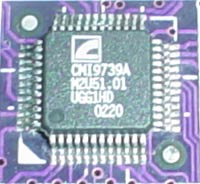ECS L4S8A (SiS 648): Value P4 Performance
by Evan Lieb on November 11, 2002 2:57 AM EST- Posted in
- Motherboards
ECS L4S8A Rev. 1: Basic Features
For the first time in quite a while, ECS puts together a fully loaded motherboard. Let's take a look at some of the specs.

We see that ECS goes with a pretty common LAN chip; Some of the fully featured motherboards we've seen have included some not-so spectacular LAN chips, and ECS's board doesn't really do anything too different by including Realtek's 8100B 10/100 chip. It's no surprise to see Realtek raking up the motherboard wins as we've had nothing but good experiences with the 8100B.
 |
 |
ECS goes with C-Media's CMI9739A chip for the onboard audio. This sound chip is a little more unconventional in the motherboards we've reviewed in the last few months, as Realtek's ALC650 or C-media's CMI8738 chip have dominated this space. The 9739A chip is a 6-channel solution much like its predecessor, however at this point we haven't had enough experience with the newcomer to determine its advantages (if any) over the more common 8738.
The L4S8A's I/O configuration is pretty standard. You get two PS/2 ports, two serial ports, one parallel port, two rear USB 2.0 ports, a LAN port, and Mic In/Line In/Line Out ports driven by the on-board CMI9739A chip. We can now confidently say that rear LAN and USB ports are standard on all the latest motherboards, be it a Socket 478 or Socket A motherboard.
 Another
feature we see ECS add to the L4S8A is Serial ATA support. Onboard Serial ATA
is powered by Silicon Image's 3112A chip, the same chip found on Intel's "enthusiast"
board (D845PEBT2) and Epox's 4PEA+. The SI 3112A chip is capable of supporting
two independent Serial ATA devices as well as RAID 0 (striping) and RAID 1 (mirroring).
This is a very nice Serial ATA chip to have, although, as mentioned here before,
onboard Serial ATA chips have to use the limited bandwidth of the PCI bus. Ideally,
motherboard manufacturers would just wait for chipset manufactures to release
chipsets with native support for Serial ATA, which would allow Serial ATA devices
to eat up the bandwidth available directly through the chipset's own I/O links,
which offer much more bandwidth (with today's chipsets, anywhere from 200 to
1000MB/s additional bandwidth, and even more in the future).
Another
feature we see ECS add to the L4S8A is Serial ATA support. Onboard Serial ATA
is powered by Silicon Image's 3112A chip, the same chip found on Intel's "enthusiast"
board (D845PEBT2) and Epox's 4PEA+. The SI 3112A chip is capable of supporting
two independent Serial ATA devices as well as RAID 0 (striping) and RAID 1 (mirroring).
This is a very nice Serial ATA chip to have, although, as mentioned here before,
onboard Serial ATA chips have to use the limited bandwidth of the PCI bus. Ideally,
motherboard manufacturers would just wait for chipset manufactures to release
chipsets with native support for Serial ATA, which would allow Serial ATA devices
to eat up the bandwidth available directly through the chipset's own I/O links,
which offer much more bandwidth (with today's chipsets, anywhere from 200 to
1000MB/s additional bandwidth, and even more in the future).
The Primary and Secondary IDE connectors support two channels each, as is always the case. Unfortunately that means the ECS L4S8A supports no more than four IDE devices, since there is no IDE RAID (just Serial ATA RAID). However, if you don't need to use more than two optical drives, two hard drives, or some other combination thereof in your system, then you should have no problem with the L4S8A's "limited" IDE support.
We see that ECS makes use of a native (chipset) feature, namely FireWire support. This is much better than having a separate FireWire chip, which would end up using the PCI bus's limited bandwidth (much like the Serial ATA chip has to). Instead, FireWire gets to use the SiS 648's interconnect, aka MuTIOL (about 1000MB/s of bandwidth). We should note that ECS takes advantage of the SiS 648's native support for FireWire (1394a) by adding two headers to the L4S8A. There doesn't seem to be a FireWire bracket bundled with the L4S8A, but perhaps ECS simply forgot to include this with our sample.
As is the norm among all modern-day chipsets, USB 2.0 support is included, courtesy of the SiS 963 South Bridge. We'd like to quickly recap the SiS 648 chipset itself, since we haven't done a SiS 648 review in a few weeks. So, as has been covered here before, the SiS 648 includes features such as:
1. AGP 3.0 (AGP 8X) support.
2. 1GB/s North-South Bridge I/O interconnect, aka MuTIOL.
3. Official Northwood-B (533MHz FSB) support.
4. Native support for USB 2.0, 1394a (FireWire), ATA133, Ethernet, and basic 6-channel sound.
5. Unofficial support for DDR400 memory (SiS648 only "officially" supports as high as DDR333 memory).










0 Comments
View All Comments